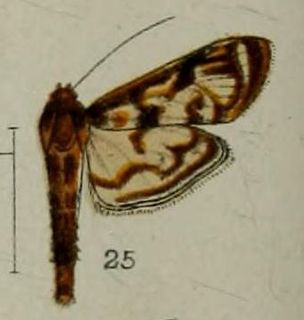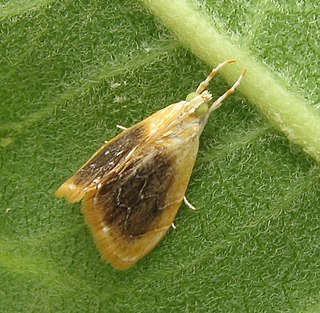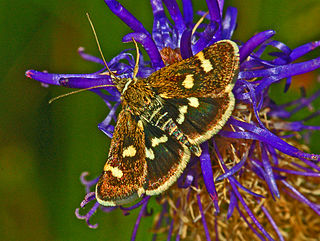
Spilomelinae is a very species-rich subfamily of the lepidopteran family Crambidae, the crambid snout moths. With 4,132 described species in 340 genera worldwide, it is the most speciose group among pyraloids.
Bacotoma is a genus of moths in the subfamily Spilomelinae of the family Crambidae. It currently comprises 11 species, with an Oriental and Australasian distribution ranging from India and Sri Lanka over China and Southeast Asia to Australia.

Heortia is a genus of moths of the family Crambidae.

Rhimphalea is a genus of small moths, which is part of the family Crambidae.

Synclera is a genus of moths of the family Crambidae described by Julius Lederer in 1863.

Glaphyria fulminalis, the black-patched glaphyria, is a species of moth of the family Crambidae described by Julius Lederer in 1863. It is found in the eastern part of the United States, from Connecticut to Florida, west to Texas and Illinois.

Ischnurges illustralis is a moth of the family Crambidae. The species was first described by Julius Lederer in 1863. It is known from Australia and New Guinea.

Bepea is a moth genus in the subfamily Spilomelinae of the family Crambidae.

Odontiinae is a subfamily of moths of the family Crambidae. The subfamily was described by Achille Guenée in 1854.
Rhimphalea sceletalis is a small moth in the family Crambidae that is found in Queensland in Australia and in Papua New Guinea. The species was first described by Julius Lederer in 1863.

Stericta flammealis is a species of moth of the family Pyralidae. It is found in Papua New Guinea.

Stericta subviridalis is a species of moth of the family Pyralidae. It is found in Papua New Guinea.

Stericta corticalis is a species of moth of the family Pyralidae. It is found in Papua New Guinea.

Glaphyriinae is a subfamily of the lepidopteran family Crambidae. It was described by William Trowbridge Merrifield Forbes in 1923. The subfamily currently comprises 509 species in 75 genera.
Scybalista restionalis is a moth in the family Crambidae. It was described by Julius Lederer in 1863. It is found in Venezuela.
Dichogama redtenbacheri, the caper-leaf webworm moth, is a moth in the family Crambidae. It was described by Julius Lederer in 1863. It is found in Florida, the West Indies, Costa Rica and South America.
Ostrinia obumbratalis, the smartweed borer, is a moth in the family Crambidae. It was described by Julius Lederer in 1863. It is found in North America, where it has been recorded from New Brunswick and Manitoba to Louisiana and Florida.
Omiodes basalticalis is a moth in the family Crambidae. It was described by Julius Lederer in 1863. It is found in Australia, Papua New Guinea and Ambon Island and Aru in Indonesia.

Polythlipta macralis is a moth in the family Crambidae. It was described by Julius Lederer in 1863. It is found on Indonesia's Ambon Island, Papua New Guinea and Taiwan.
Pycnarmon praeruptalis is a moth in the family Crambidae. It was described by Julius Lederer in 1863. It is found on Indonesia's Ambon Island and Papua New Guinea.












